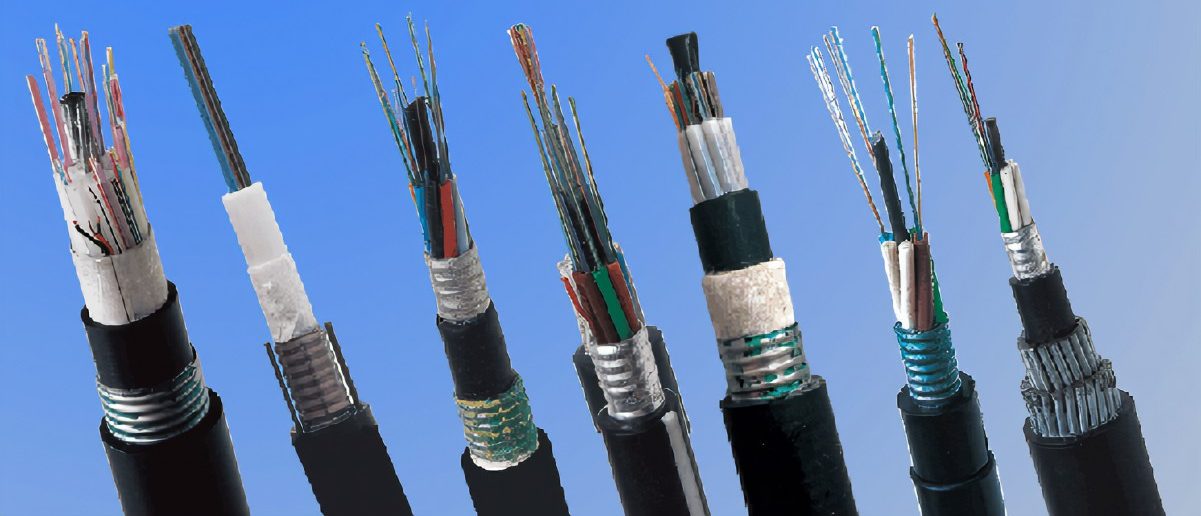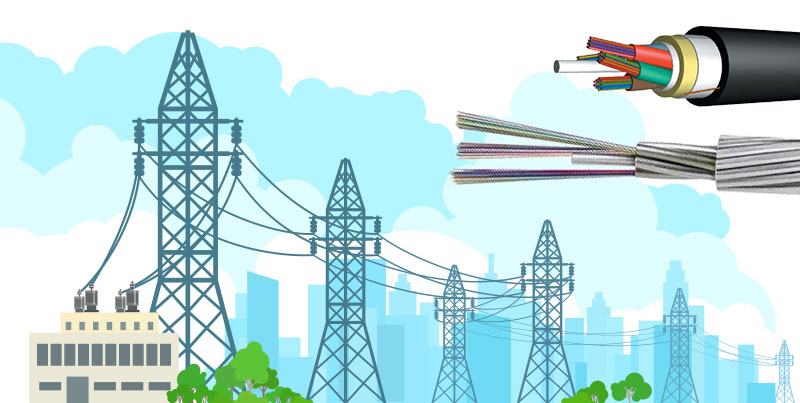Шилэн оптик кабелийн кабель нь харилцаа холбоо, мэдээллийн дамжуулалтыг хувьсгал болгосон. Эдгээр кабель нь өгөгдлийг дамжуулахын тулд гэрлийг ашигладаг, уламжлалт зэс утсаар мэдэгдэхүйц давуу талыг санал болгодог, Үүнд илүү өндөр зурвасын өргөн, хурдан хурд, цахилгаан соронзон хөндлөнгийн оролцоотой харьцуулахад. Энэхүү эссэ нь шилэн оптик кабелийн ангилалд хуваагдана, өөрсдийн өргөдлийг судалж үздэг, хөгжлийг нь ул мөр.




Шилэн оптик кабелийн ангилал
Шилэн оптик кабелийг хэд хэдэн шалгуур дээр үндэслэн ангилдаг, эслэгийн төрлийг оруулаад, дамжуулах горим, ба кабелийн барилгын ажил.
1. Эслэгийн төрөл
Шилэн оптик цахилгаан эрчим хүчний кабелийг хоёр төрөлд өргөнөөр ангилах боломжтой: Нэг горимын эслэг (Сми) ба олон горимын эслэг (Эвэмхамтраа баг).
Нэг горимын утас (Сми):
- Цөмийн дотоод бүсилхий: Ихэвчлэн эргэн тойронд байдаг 8-10 микрометр.
- Дамжуулах зай: Холын зайны дамжуулалт хийх чадвартай, ихэвчлэн харилцаа холбоо, урт хугацааны мэдээллийн сүлжээнд ашигладаг.
- Гэрлэлт: Лазер диод ашигладаг.
- Зурвасын өргөн: Хамгийн бага модлог тархалтаас болж өндөр зурвасын өргөн чадвар.
- Хэрэглээ: Өгөгдлийн өндөр түвшний ханш шаардагдах өргөдлийг шаарддаг програмд тохиромжтой, метрополитан, өргөн хүрээний сүлжээ зэрэг (Хүн).
Олон горимын эслэг (Эвэмхамтраа баг):
- Цөмийн дотоод бүсилхий: Мужаас 50 руу 62.5 микрометр.
- Дамжуулах зай: Богино зайд хязгаарлагддаг, ихэвчлэн хэдэн км хүртэл байдаг.
- Гэрлэлт: Гэрлийг ялгаруулдаг диод ашигладаг (Хялбар).
- Зурвасын өргөн: Доод зурвасын өргөнийг Modal Dission-ийн улмаас SMF-тай харьцуулахад SMF-тай харьцуулахад.
- Хэрэглээ: Орон нутгийн сүлжээнд түгээмэл хэрэглэгддэг (Хар тань), мэдээллийн төвүүд, болон барилгын холбоосууд.
2. Дамжуулах горим
Шилэн оптик кабелийг дамжуулж буй горим дээр үндэслэн ангилах боломжтой:
Алхам-индекс индекс эслэг:
- Бүтэц: Гол нь жигд хугарлын индекстэй байдаг, Нөмрөгт гэнэт өөрчлөгдөнө.
- Дэлгэлтэх: Өндөр модаль тархалт, холын зайнд өндөр хурдны өгөгдлийг дамжуулахад бага тохирох болно.
- Хэрэглээ: Үндсэндээ өртөг нь чухал хүчин зүйл, дамжуулалтын зай богино байгаа програмуудад ашиглагддаг.
Градус-индекс индекс эслэг:
- Бүтэц: Гол хугарлын индексийг төвөөс аажмаар эргүүлэв.
- Дэлгэлтэх: Алхам-индексийн утастай харьцуулахад модаль диспрейкийг багасгасан, Илүү өндөр өгөгдөл дамжуулах хурдыг зөвшөөрөх.
- Хэрэглээ: Олон горимын шилэн програмуудад өргөн хэрэглэгддэг, жишээ нь Лан, дата төвүүд.
3. Кабелийг барих
Оптик шилэн кабель нь хүрээлэн буй орчны янз бүрийн нөхцөл, суурилуулах шаардлагад нийцүүлэн янз бүрийн аргаар баригдсан болно. Үндсэн төрлүүд орно:
Хатуу буферлэсэн кабель:
- Бүтэц: Шилэн бүрийг хамгаалах буфер давхаргын давхаргаар бүрсэн байдаг.
- Уян хатан байдал: Харьцангуй уян хатан байдал, хөнгөлөлтийг санал болгодог.
- Хэрэглээ: Доторх хэрэглээнд ашигладаг, нөхөөс утас, ширээний холболт гэх мэт.
Сул хоолойны кабель:
- Бүтэц: Шигнүүд нь гель дүүргэсэн эсвэл хуурай усаар хаах хоолойд багтдаг.
- Хамгаалалт: Чийгтэй адил байгаль орчны хүчин зүйлээс хамгаалдаг.
- Хэрэглээ: Гадаа програмд тохиромжтой, тухайлбал урт зай, шууд булшлах суулгац.
Хуягт кабель:
- Бүтэц: Механик хамгаалалтад зориулсан хуяг нэмэлт давхаргыг багтаана.
- Бат бөх чанар: Бие махбодийн эвдрэлээс хамгаалах хамгаалалтыг санал болгодог.
- Хэрэглээ: Кабель нь бие махбодийн боломжийн хохирол учруулж буй орчинд ашигладаг, Аж үйлдвэрийн тохиргоо, шууд булшлах суулгац гэх мэт.

 Уурхайн оптик кабел нь нүүрсний уурхай, галын үлдэгдэлтэй харилцах харилцааны оптик кабель нь нүүрсний уурхай эсвэл нүүр нүүрснийхээ харилцааны оптик кабель юм
Уурхайн оптик кабел нь нүүрсний уурхай, галын үлдэгдэлтэй харилцах харилцааны оптик кабель нь нүүрсний уурхай эсвэл нүүр нүүрснийхээ харилцааны оптик кабель юм
Шилэн оптик кабелийн програмууд
Шилэн оптик кабель байна янз бүрийн үйлдвэрлэлийн өргөн хүрээний програмууд Өндөр өгөгдөл дамжуулах чадвар, найдвартай байдал, найдвартай байдал.
1. Харилцаа холбоо
Шилэн оптик кабелийн кабель бол орчин үеийн харилцаа холбооны сүлжээний арын нуруу юм. Тэд хамгийн бага хурдтай өгөгдлийг хамгийн бага алдагдал, хөндлөнгөөс оролцуулдаг.
Түлхүүр програмууд орно:
- Интернэт нуруу: Шилэн оптик цахилгаан кабелийн цахилгаан кабелийг дэлхийн интернетийн үндсэн дэд бүтэц үүсгэдэг, Улс, тивийн хоорондох өндөр хурдны өгөгдлийг хөнгөвчлөх.
- Өргөн зурвасын үйлчилгээ: Өндөр хурдтай интернетийн үйлчилгээг гэр, бизнес эрхлэхэд ашигладаг.
- Дуу ба видео харилцаа холбоо: Өндөр чанартай дуу хоолой, видео харилцааны үйлчилгээг дэмждэг, үүнд ip-ийн дуу хоолой орно (VoIP) болон видео хурал хийх.
2. Дата төвүүд
Мэдээллийн төвүүдэд, Шилэн оптик кабелийг холбосон серверүүдийг холбоход зайлшгүй шаардлагатай, Хадгалах системүүд, сүлжээний тоног төхөөрөмж. Эдгээр нь үр дүнтэй боловсруулалтыг боловсруулж, шилжүүлэхэд шаардагдах өндөр зурвасын өргөн, бага хоцрогдолыг санал болгодог.
Түлхүүр програмууд орно:
- Хадгалах бүсийн сүлжээ (Соос): Шилэн оптик кабелийн кабелийн кабелийн төхөөрөмжийг серверүүдэд холбодог, Хурдан, найдвартай өгөгдлийг нэвтрэх боломжийг идэвхжүүлж байна.
- Үүл тооцоолох: Cloud Service болон Data Center Countike-д шаардлагатай өндөр хурдтай холболтыг дэмждэг.
3. Эмнэл мэндийн ажилчид
Шилэн оптик кабелийн кабелийг жижиг хэмжээтэй холбоотойгоор янз бүрийн эмнэлгийн програмд ашигладаг, уян хатан байдал, Электрометик хөндлөнгийн оролцоогүйгээр өгөгдлийг дамжуулах чадвар.
Түлхүүр програмууд орно:
- Эндоскопи: Шилэн оптик кабелийн кабелийг Элсоскопоор гэрэлтүүлж, бие махбодийн дотор зургуудыг дамжуулахад ашигладаг.
- Эмнэлгийн төлөөлөрмоог харах: Мэдээлэл дамжуулахад MRI болон CT Scaners гэх мэт дүрслэл төхөөрөмжүүдэд ашигладаг.
4. Цэргийн ба аперфатор
Цэргийн болон аэроссазын салбарууд нь шилэн секторууд нь шилэн оптик кабелийг найдвартай, найдвартай, найдвартай дамжуулах. Түлхүүр програмууд орно:
- Авионикс: Шилэн оптик кабелийг өгөгдлийн харилцах, навигацийн системд онгоцонд ашигладаг.
- Цамын харилцаа холбоо: Цэргийн үйл ажиллагаанд аюулгүй, өндөр хурдны харилцааны холбоосыг өгдөг.
5. Аж үйлдвэрийн автоматжуулалт
онд Аж үйлдвэрийн автомат, Шилэн шилэн утас нь мэдрэгчийг холбоход ашигладаг, тохиолдолд хүрээлэн, автоматжуулсан систем дэх бусад төхөөрөмжүүд. Түлхүүр програмууд орно:
- Үйлдвэрийн автоматжуулалт: Машин ба хяналтын системүүдийн хооронд бодит цагийн харилцааг хөнгөвчилдөг.
- Шат боловсруулах: Аж үйлдвэрийн үйл явцыг хянах, хянах.
6. Нэвтрүүлэг ба зугаа цэнгэл
Нэвтрүүлэг ба үзвэр үйлчилгээ нь өндөр чанартай аудио болон видео дамжуулах зориулалттай шилэн оптик кабелийг ашигладаг. Түлхүүр програмууд орно:
- Телевизийн нэвтрүүлэг: Шилэн оптик кабелийн кабелийн кабель нь Television нэвтрүүлгийн өндөр түвшний видео дохиог дамжуулах.
- Азтай үйл явц: Амьд үйл явдлыг нэвтрүүлэхэд ашигладаг, спорт, концерт гэх мэт, Өндөр чанартай аудио, видео тэжээл өгөх.

 Интернэтэд зориулсан шилэн кабель
Интернэтэд зориулсан шилэн кабель
Шилэн оптик кабелийг хөгжүүлэх
Шилэн оптикийн кабелийг хөгжүүлэх нь ДЭЛГЭРЭНГҮЙ МЭДЭЭЛЛИЙН МЭДЭЭЛЛИЙН ТӨЛӨВЛӨГӨӨГҮЙ ЗӨВЛӨГӨӨ, Илүү том зурвасын өргөн, болон илүү найдвартай харилцааны системүүд.
1. Эрт хөгжил
Харилцаа холбооны огцом мэдээллийг ашиглан 19-р зууны үед гэрлийг ашиглах тухай ойлголт, Александр Грэм Беламын зурагны шинэ бүтээлийг оруулав 1880. Гэсэн хэдий ч, Энэ нь 1960-аад оны практик шилэн оптик харилцааны систем гарч эхлэв.
1960с:
- Онолын үндэс суурь: Чарльз Као Као, Жорж Хоккхэм нар онолын талаар тавьсан шилэн оптик харилцааны суурийг, өгөгдлийн дамжуулалтыг дамжуулахын тулд шилэн утас ашиглах боломжийг харуулна.
- Эхний шилэн оптик кабель: Эрт шилэн шилэн оптик кабелийн эхэн кабель нь дохионы алдагдалд өндөр түвшинтэй байв, холын зайн харилцаанд тохиромжгүй болгох.
2. Технологийн дэвшил
1970-аад оны 1970-аад оны болон 1980-аад оны болон 1980-аад оны 1980-аад оны үед, 1980-аад оны үед шилэн оптик кабелийн үрчлэгдсэн.
1970с:
- Алдагдал багатай утас: CERNAN DEARDER дээр судлаачид нь бага алдагдалтай оптик утас боловсруулжээ, практик хэрэглээнд тохирох түвшний дохиог буурах түвшинг бууруулах.
- Ласс технологи: Лазер Технологийн урьдчилгаа нь шилэн оптикийн харилцааны үр дүнтэй гэрлийн эх үүсвэрийг хөгжүүлэх боломжийг олгосон.
1980с:
- Ягаан оптик сүлжээ: Эхний арилжааны шилэн шилэн оптик сүлжээг байршуулсан, Дата дамжуулах хурдны хурд, уламжлалт зэсийн кабелийн талаар мэдэгдэхүйц сайжруулалтыг санал болгож байна.
- Стандартын чанар: Fible Optic Cove Cables-ийн үйлдвэрлэлийн стандартыг хөгжүүлэх.
3. Сйнд орчин үеийн
1990-ээд оны болон 2000с, 2000с нь шилэн оптик технологид үргэлжлүүлэн хөгжсөн байхыг харсан, өндөр хүчин чадалтай сүлжээ, шинэ програмуудыг хөгжүүлэхэд хүргэдэг.
1990с:
- Өтгөн долгионы уртыг диваажин (DVDM): DWDM технологи нь олон өгөгдлийн сувгийг нэг эслэгээр дамжуулж өгөх боломжийг олгодог, зурвасын өргөнийг мэдэгдэхүйц нэмэгдэж байна.
- Дэлхийн шилэн оптик сүлжээ: The Глобал шилэн шилэн оптик сүлжээг байрлуулах, үүнд үүнд intersea кабель орно, Тивээс өндөр хурдтай өгөгдлийн харилцааг идэвхжүүлсэн.
2000s ба түүнээс цааш:
- Гэрт шилэн (FTTH): The rollout of FTTH networks brought high-speed internet access directly to consumers’ homes.
- Шилэн технологийн дэвшил: Үргэлжилж буй судалгаа, хөгжил нь хэт бага алдагдалтай утас үүсгэхэд хүргэсэн, нугалахад мэдрэмтгий утаснууд, шилэн оптик кабелийн гүйцэтгэл, найдвартай байдлыг сайжруулдаг бусад шинэлэг зүйлүүд.
Шилэн оптик утас, кабелийн гар утас нь харилцаа холбоо, мэдээллийн дамжуулалтыг хувиргасан, Хууль бус хурдыг санал болгох, зурвасын өргөн, болон найдвартай байдал. Тэдгээрийн ангилал нь шилэн төрөлд суурилсан, дамжуулах горим, Барилгын барилга нь тэдний олон давталт, дасан зохицох чадварыг янз бүрийн програмд тусгасан болно. Шилэн оптик кабелиуд нь бидний улам бүр холбогдсон ертөнцөд зайлшгүй шаардлагатай байдаг, харилцаа холбооны болон өгөгдлийн төвөөс эмнэлгийн төвөөс, цэрэг, аж үйлдвэрийн, болон зугаа цэнгэлийн салбарууд. Шилэн оптик технологийг хөгжүүлэх, тасралтгүй инновацийн замаар жолооддог, Эдгээр кабелууд нь олон жилийн турш харилцааны системийн эхэн дээр үлдэх болно.



